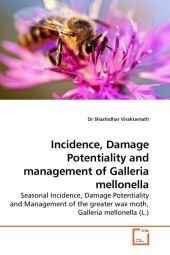 Neuerscheinungen 2010Stand: 2020-01-07 |
Schnellsuche
ISBN/Stichwort/Autor
|
Herderstraße 10
10625 Berlin
Tel.: 030 315 714 16
Fax 030 315 714 14
info@buchspektrum.de |

Shashidhar Viraktamath
Incidence, Damage Potentiality and management of Galleria mellonella
Seasonal Incidence, Damage Potentiality and Management of the greater wax moth, Galleria mellonella (L.)
2010. 284 S.
Verlag/Jahr: VDM VERLAG DR. MÜLLER 2010
ISBN: 3-639-24792-2 (3639247922)
Neue ISBN: 978-3-639-24792-3 (9783639247923)
Preis und Lieferzeit: Bitte klicken
Greater wax moth, Galleria mellonella (L.) is the most serious enemy of all the Apis species of honey bees throughout the world causing damage to combs and hive products both in storage and in live colonies. Injury by the larvae is so disastrous that the combs may completely be reduced to a mass of webbing and debris within a short time forcing the colonies to abscond. Its destructive activities are more severe in the tropics and subtropics, presumably because the pest is believed to have evolved in southern Asia along with honey bees. India is one of the major honey and wax producing countries in the world. Hence, this publication provides exhaustive information on the seasonal incidence of the pest in four Apis species of honey bees, its damage potentiality in storage, its natural enemies and biology and efficacy of the most dominant parasitoid, Apanteles galleriae .Efficacy of commercial formulations of Bacillus thuringiensis and botanicals have been presented and an integrated management package has been evaluated. This publication forms baseline information on the greater wax moth and an important reference document to students, researchers and teachers.
Dr. Shashidhar Viraktamath is a Professor at the Department of Entomology, University of Agricultural Sciences, Dharwad, India. His areas of research include, Insect Systematics, fruit fly management and bee pollination. Currently he is working on morphological and genetic diversity of honey bees and stingless bees in India and on bee attractants.


